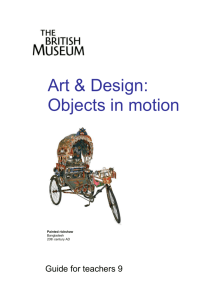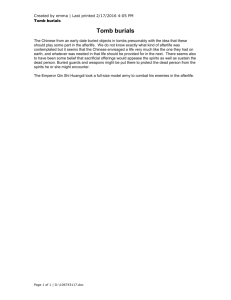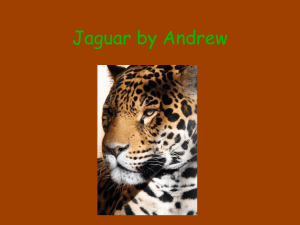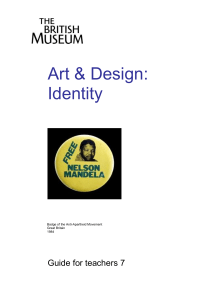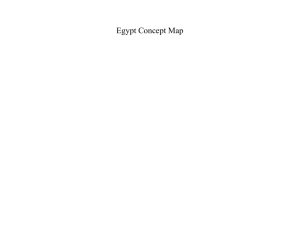The Natural World
advertisement
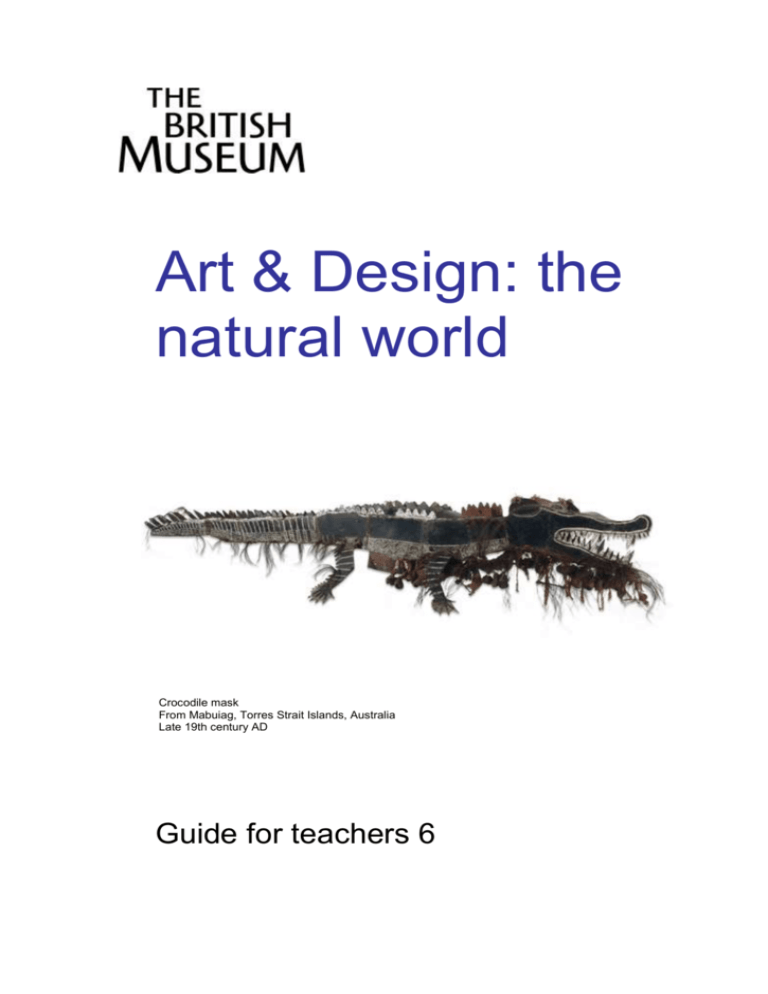
Art & Design: the natural world Crocodile mask From Mabuiag, Torres Strait Islands, Australia Late 19th century AD Guide for teachers 6 Art and Design: the natural world Introduction Art & Design guides for teachers The collections of the British Museum have inspired artists for hundreds of years and are a rich source of ideas and stimulation for teachers and students alike. This series of ten guides is intended to help primary and secondary teachers to use the objects in the British Museum collections for teaching art and design. This will support students’ research skills, knowledge and understanding in order to make their practical work more meaningful and contextualised. Each guide focuses on a topic. Each topic is analysed through four or five themes, each of which is illustrated with a museum object, from different historical periods and world cultures. These topics, themes and objects have been specially chosen so that you and your students can use them as starting points to explore the collections further, either at the Museum or online. Each guide ends with points for classroom discussion and brief ideas for starting off activities and projects. The guides in the series are: 1 Containers 2 Sculpture 3 Textiles 4 Symbols 5 Celebration 6 The Natural World 7 Identity 8 Gods and spirits 9 Objects in motion 10 Death and the afterlife All the objects have been taken from the Museum’s online database, available through: www.britishmuseum.org/explore/introduction.aspx. There you can find high quality images which can be copied into your own presentations for the classroom or for students to download. Contextual understanding In order to develop their critical thinking, students should examine the following when considering any museum object: Origin: Materials: Process: Function: Meaning: Who made it? Where and when was it made? What is it made from? How was it made? What was it used for? What does it mean? Once students have understood the context, they can analyse the form and decoration of the object which are usually determined or influenced by all these aspects. Art and Design: the natural world Introduction World cultures The guides are not based around a particular cultural or geographical region. If you wish to focus your study on, for example, objects from Africa then use the list below, where the guides which contain objects from particular regions have been grouped. Africa Death and the afterlife, Gods and spirits, Identity, Sculpture, Symbols, Textiles, The Americas Celebration, Containers, Gods and spirits, Symbols, Textiles, Natural World Asia Celebration, Containers, Death and the afterlife, Gods and spirits, Objects in motion, Sculpture, Europe Celebration, Containers, Death and the afterlife, Gods and spirits, Identity, Objects in motion, Sculpture, Textiles, Natural World Middle East Gods and spirits, Sculpture, Natural World Oceania Containers, Death and the afterlife, Gods and spirits, Sculpture, Symbols, Natural World Cross-curricular topics Citizenship Many of these topics tap into citizenship themes such as local and national identity, globalisation and global issues, and the impact of the media. History The objects are from a variety of historical contexts and periods. Research and discussions about the use of clothing for status and the importance of symbols are central to exploring images as evidence in history. Geography Examining objects from specific cultures is an excellent way of understanding how humans interact and cope with living and surviving in different environments. Religious Education Many of these objects have some spiritual significance. Those relating to the afterlife and deities are ideal starting points for considering similarities and differences in belief systems . Art and Design: the natural world Themes The Natural World Humans have always used, interacted with, observed, and adapted the natural environment which surrounds them. Objects reveal to us the ways this relationship has worked within different cultures and societies over time. As human society has developed, through urbanisation and technology, we can feel increasingly distanced from the natural world. However, as animals ourselves, the natural world is where we have all come from. Through objects, we can understand how different societies function in and around the environment. Animals in belief systems Animals play an important role in the belief systems of many different societies. Animals’ traits were observed by humans which led to the image of the animal entering into the symbolic language of the society. In the Teotihuacan culture (Mesoamerica, 150 BC to AD 750), the jaguar was a central symbol within the belief system. As the quickest, most agile and dangerous predator in the jungle, the jaguar came to symbolise strength, power and domination. Rulers in Mesoamerican cultures associated themselves with the authority and hunting prowess of the jaguar. This calcite onyx jaguar was a ritual container which may have been a vessel for human hearts extracted in ritual sacrifices. The style of its carving has reduced the animal to its characteristic features. Reverence for jaguars can be observed in many murals in temples in the region. Maya rulers incorporated jaguars into their names – such as Bird Jaguar and Shield Jaguar from the late Mayan period (AD 600 – 900). The representation of the jaguar as a symbol of power can be compared with that in Benin in West Africa, another region of equatorial rainforest, where the ruler, the oba, associated himself with the leopard, the king of the jungle. Art and Design: the natural world Themes Inspiration from plants Forms from plants and flowers are an important component of Islamic art. Known as arabesque, floral and plant designs are configured into geometric forms that are painted on tiles, which decorate buildings, mosques in particular, and on ceramic containers. That these patterns can continue infinitely supports the Islamic belief in existence extending beyond the visible material world. In Ottoman Turkey, the style known as Iznik developed which incorporated specific colours from natural pigments – in particular blue, green and red on a white background. Creating from natural materials The natural world provides us with our basic materials for creating objects, although this is not always obvious. With some objects, the natural origins of the material are highly visible and manipulated to create the form. This spectacular mask, which is over 2 metres long (crocodile-life-size) from the Torres Strait islands is made from several different natural materials using various processes. Turtle shells were heated to allow them to be moulded and were then drilled and bound together with cord. Other decorative elements have been added with seedcase rattles, cassowary feathers, wool, cloth, jawbones, nuts and wood carved and coloured with natural pigments. Masks such as this were used in various ceremonies, such as agricultural celebrations to promote fertility and celebrate harvests, in initiation rites, to protect the people against crocodiles and to ensure successful hunting expeditions. Art and Design: the natural world Themes Early observation of nature Natural curiosity as well as the need for survival led early peoples to analyse the animals surrounding them closely. These animals were their source of food, their skins for clothing and their bones for utensils, so understanding the migration and feeding patterns was vital. This carved rib is about 12,500 years old. Antlers, bone and stone have also been discovered from this period with intricately carved reindeer and ibex. The heads at the far left and in the centre, with the antlers, are reindeer whilst the head between them is an ibex, recognisable by the shading and short beard. On the far right is a reindeer without antlers. Art and Design: the natural world Activities and art projects General discussion Where are examples of naturally inspired designs used at home, in school or elsewhere? What different environments are near the school? What materials for creating art would these provide? Discuss the way environments can be damaged – what are the effects? Start thinking on the local scale and then think globally. Consider modern ethical and environmental concerns regarding the use of natural resource sand effects on the natural world. Research arguments surrounding global warming, organic food production, recycling and energy sources – how do modern lifestyle, financial issues and other concerns impact upon our ability to react to these concerns? Research relationships that different cultures have with the natural world, such as Native North American or Polynesian peoples. Projects and activities Primary A walk Go on a walk and collect natural ‘junk’. Use these to create a mural in the classroom reflecting the local environment. Creation tales Read creation myths and folk tales which attempt to explain the natural world. Use these for inspiration to create character masks based on these stories – use recycled and natural materials to decorate these. Art and Design: the natural world Activities and art projects Primary continued A display Create a ‘natural world’ corner in the classroom with leaves, twigs, shells, stones, sand etc. Use this to start discussions about smells, texture, colour and sounds. Collecting Collect different plants and leaves and create repeating patterns. Use these as the starting point for the design for a tile – use blue, green and red only onto a white cardboard square. Secondary Stylised animals Using the Teotihuacan jaguar as the starting point, explore the British Museum website to find other animals which have been stylised and abstracted such as in Aztec and Mayan art, in Benin and in ancient Chinese culture. Make drawings of different wild animals and practise refining their features using bold shapes and lines. Campaign imagery Students could research some recent high profile environmental campaigns, exploring the way they combine events, images, newspaper articles, stunts and slogans to highlight their cause. They could choose an environmental campaign and design an eye-catching piece of campaign material – a poster, presentation, photograph, collage or film for example. Wild vs. manmade landscapes Examine how humans have attempted to organise landscapes and gardens, and how some have tried to replicate the wild, whereas others seek to control it. Find examples of landscapes in works of art and alter them using a digital image manipulating programme to convey a contemporary image. Art and Design: the natural world Illustrations Calcite onyx ritual container in the form of a jaguar Teotihuacan culture (150 BC - AD 750) From Mexico Underglaze-painted tiles Ottoman, about AD 1550 From Iznik, modern Turkey 21 x 21 cm Crocodile mask From Mabuiag, Torres Strait Islands, Australia Late 19th century AD L: 2.13m Line of animal heads engraved on a rib Late Magdalenian, about 11th century BC From the cave of Courbet, Penne-Tarn, France L: 11.3 cm Illustrations
